The Society for Bangladesh Agricultural Extension Network (BAEN) recently organized a survey among Extension and Advisory service providers in Bangladesh to understand the challenges faced by farmers due to COVID-19 and the effectiveness of the measures aimed at addressing them. In this blog, Dr. Sekender Ali presents findings from this survey.
CONTEXT
COVID-19 has impacted all sub-sectors of agriculture (crop, livestock and fisheries) in Bangladesh. The nationwide lockdown strategy included several protective measures that resulted in restricted access to agricultural products, inputs, markets and Extension and Advisory Services (EAS). These restrictions, which were in place till 30 May 2020, significantly affected farming, including food supply and demand. Agricultural Extension in South Asia previously published two blogs on the impact of COVID-19 and the role of EAS in addressing some of these issues. In April 2020, the Society for Bangladesh Agricultural Extension Network (BAEN) decided to conduct an online survey to assess the effects of COVID-19 on Bangladesh’s agriculture and the effectiveness of interventions. The online survey link was mailed to EAS professionals (representing the public, private and NGO sector). As many as 117 EAS professional responded to the survey. A breakup of respondents by sector of representation has been presented in Figure 1.
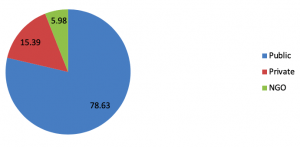 Figure 1: Percentage of respondents from public, private and NGO organizations
Figure 1: Percentage of respondents from public, private and NGO organizations
MAJOR FINDINGS OF THE STUDY
The findings of the online survey to assess the effects of COVID-19 on Bangladesh Agriculture and the effectiveness of interventions are discussed below.
Problems faced by farmers of Bangladesh due to COVID-19
Due to COVID-19, farmers of Bangladesh are facing different types of problems in varying degrees. BAEN members made an exhaustive list of these problems from different media sources (print and television) and through consultations with relevant EAS experts. This list was further modified and validated by BAEN’s Executive Committee and finally 28 items were included in this study.
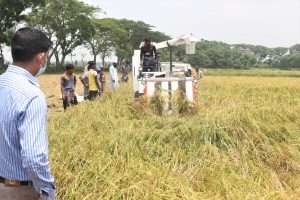
Respondents were asked to mention their opinion on the extent of difficulty experienced by farmers due to a select problem as a result of the pandemic. They highlighted their response (‘severe problem’, ‘moderate problem’, ‘low problem’ and ‘no problem’). Out of these 28 items, the respondents felt 22 problems were very severe (Box 1).
Box 1. Problems perceived as severe by the respondents
|
Problems related to “wastage and low price of farmers’ products (vegetables, fruits, egg, milk, meat, flower, shrimp, crab, etc.) at farm gate or local market due to disconnect with the customer, absence of traders (middle men as collectors, transporters wholesalers, etc.) and vehicles for transport” were the top ranked problems. Severity of top ranked five problems is presented diagrammatically in Figure 2.
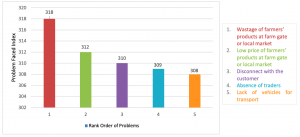 Figure 2: Top five problems that are assessed as severe
Figure 2: Top five problems that are assessed as severe
Initiatives taken by different organizations to minimize problems faced by the farmers of Bangladesh due to COVID-19 Pandemic
Different organizations of Bangladesh have taken several initiatives to mitigate problems faced by the farmers of Bangladesh due to COVID-19. Perception on effectiveness of these initiatives vary considerably. BAEN members made an exhaustive list of these initiatives to include in the study.
Respondents were asked to mention their perception on the degree of effectiveness of these initiatives by highlighting the correct response – ‘highly effective, ‘moderately effective, ‘low effective’, and ‘not effective’. The initiatives organized on the basis of rank order for effectiveness are presented in Box 2.
| Box 2. Rank order of initiatives to minimize COVID related problems faced by the farmers
Highly effective Initiatives
Moderately effective Initiatives
|
Findings revealed that among the 25 initiatives, five were highly effective and 20 were moderately effective. It was also found that initiatives related to the Prime Minister’s directions – to cultivate every inch of land for more crop production, implement continuous agricultural activities for ensuring food security, arrange weekly haat (makeshift market) in open field in every area to help farmers for selling their produce by maintaining social distance, ensuring all time presence of DAE staff in respective working areas and allocation of BDT. 9,000 crore as fertilizer subsidy – were identified as the top ranked initiatives i.e. the highly competent initiatives. Effectiveness of top ranked five initiatives is presented diagrammatically in Figure 3.
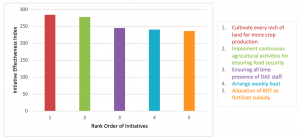 Figure 3: Top five initiatives ranked as effective
Figure 3: Top five initiatives ranked as effective
RECOMMENDATIONS TO MINIMIZE THE IMPACT OF COVID 19
Based on the above findings, a few suggestions to minimize the problems being faced by farmers of Bangladesh are mentioned below:
- Strictly follow the Prime Minister’s directions that have been shown as highly effective.
- All time presence of Extension and Advisory Service (EAS) providers at local working areas for technical support to crop, livestock and fisheries sectors to minimize their problems.
- Effective collaboration and coordination among public and private Extension & Advisory Services (EAS) providers, with BAEN responding to immediate threats to Bangladesh’s agriculture.
- Strengthen digital advisory services and provide information on output prices, availability of inputs, etc.
- Arrange proper marketing system to sell farmers’ produce (vegetables, fruits, egg, milk, meat, flower, shrimp, crab, etc.), so that they can benefit by getting fair price with minimum wastage.
- Arrange e-marketing system to help farmers buy inputs and sell agro-products in collaboration with BAEN, government’s extension organizations (DAE, DLS, DOF, etc.), NGOs (SDI, BASA, iDE, OXFAM, Practical Action, HELVETUS, etc.) and private organizations (One Bangladesh, Matrix, ABC Start-up Ltd. Etc.).
- Organize proper transport system for marketing farmers’ products by taking subsidy or aid from donor and development organizations.
- Organize proper transporting and distribution system to transport agricultural inputs from manufacturing and marketing companies to local dealers and farmers.
- Proper monitoring and distribution of government subsidies, grants, incentives, credit, etc. for betterment of farmers.
- Strengthen cooperative farming and marketing systems.
- Ensure migration of agricultural labour from surplus areas to the deficit areas of the country while ensuring proper healthcare for them.
- Increase agricultural mechanization facilities for farmers.
- Providing low interest credit to farmers’ groups (common interest groups formed by DAE, farmer groups of NGOs) to buy large agricultural equipment like rice harvesters with matching government subsidy so that small and marginal farmers can harvest their rice and also earn money by cutting other farmers’ rice.
- Providing incentives to crab, mud eel and flower farmers as their products are not saleable due to lockdown of airport and lack of customers; temporally, these areas may be used for producing other crops with incentives.
- Educate farmers about hygiene measures such as handwashing, wearing masks, staying home if sick and maintaining social distancing.
- Ensure vehicle, insurance, incentive, PPE, sanitizer products, etc. for EAS personnel.
- Ensure grants from development partners (FAO, IFAD, other donors, development banks, etc.) for:
- Increasing the capacity of EAS providers
- Increasing capacity of small and marginal farmers to buy agricultural implements
- Establish low cost cold storage facilities at farmers areas
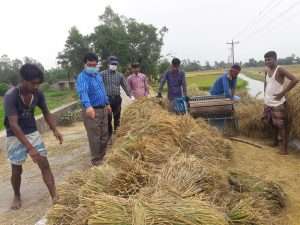
CONCLUSION
BRAC Survey (2020) reported that the agriculture sector took a major hit as farmers across the country suffered a steep loss of approximately BDT 565.36 billion (56,536.68 crore) during the public holiday (March to May 2020) announced to contain COVID-19. Nationwide lockdown was continued in Bangladesh up to 30 May 2020.
Presently, the country is divided into Red, Yellow and Green Zones based on the severity of pandemic. The lockdown continues in Red Zones. Due to this, agricultural sectors are suffering. Severity of problems faced by the farmers of Bangladesh are mentioned in Box 1 and Figure 2. To minimize the problems faced by farmers, several organisations and the Government of Bangladesh have taken several initiatives. Effectiveness of these initiatives is presented in Box 2 and Figure 3. After conducting this survey, at the time of Eid-ul Fitr, the government provided BDT. 2500.00 to each of the 50 lakh low income population directly by using cell phone account which was very effective in minimising people’s problems which were not included in the initial list of the survey.
Bangladesh Army played a major role by collecting vegetables and fruits from farmers at legally prescribed prices and distributing it among low income people, which was also beneficial for both the producing farmers and the needy. A private organization is trying to introduce online marketing for farmers’ products, while another organization, Matrix, started online shop for farmers’ products. As per suggestion of BAEN, Matrix is producing quality agricultural food through their contact farmers and those are being marketed by this online shop.
SDI (an NGO) is trying to collect their beneficiary farmers’ products to market in Dhaka city. SDI is facing transport problems, as the transport workforce is not willing to work during the pandemic. The transport costs are also very high. SDI is trying to arrange a subsidy from IFAD for transporting farmers’ produce. All these organizations have committed to work with BAEN for the welfare of the farmers of Bangladesh.
References
BRAC 2020. Rapid Perception Survey on COVID19 Awareness and Economic Impact. BRAC, Bangladesh
 Dr. Md. Sekender Ali is a Professor, Department of Agricultural Extension & Information System & Pro-Vice Chancellor, Sher-e-Bangla Agricultural University, Dhaka and Secretary General, Society for Bangladesh Agricultural Extension Network (BAEN) (Email: msa_sau@yahoo.com)
Dr. Md. Sekender Ali is a Professor, Department of Agricultural Extension & Information System & Pro-Vice Chancellor, Sher-e-Bangla Agricultural University, Dhaka and Secretary General, Society for Bangladesh Agricultural Extension Network (BAEN) (Email: msa_sau@yahoo.com)

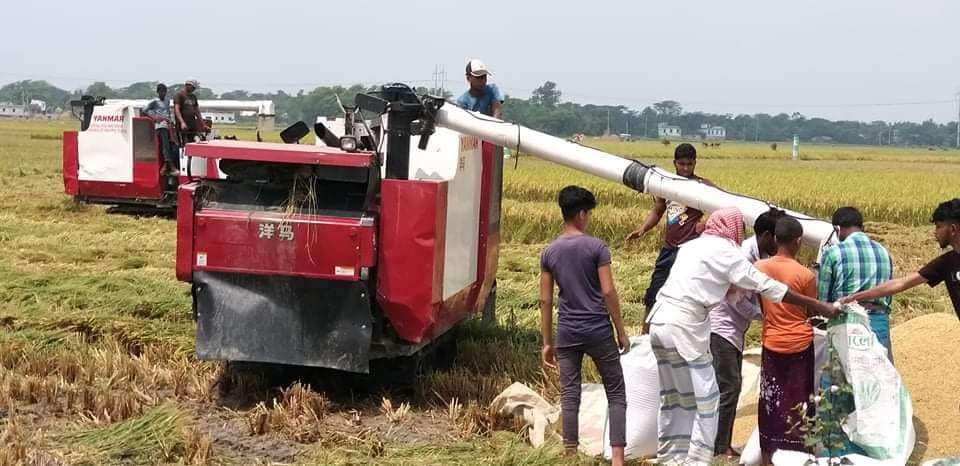

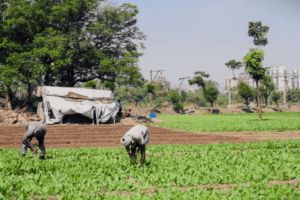

Add Comment